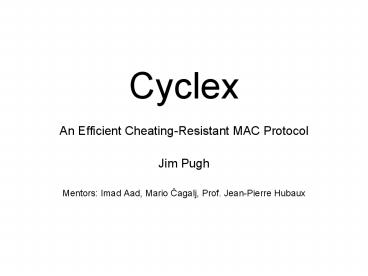Cyclex - PowerPoint PPT Presentation
1 / 23
Title:
Cyclex
Description:
Cyclex An Efficient Cheating-Resistant MAC Protocol Jim Pugh Mentors: Imad Aad, Mario agalj, Prof. Jean-Pierre Hubaux Outline Problem with current protocol Cyclex ... – PowerPoint PPT presentation
Number of Views:38
Avg rating:3.0/5.0
Title: Cyclex
1
Cyclex
- An Efficient Cheating-Resistant MAC Protocol
- Jim Pugh
- Mentors Imad Aad, Mario Cagalj, Prof.
Jean-Pierre Hubaux
2
Outline
- Problem with current protocol
- Cyclex protocol description
- How Cyclex solves current problem
- Pros and cons of Cyclex
3
IEEE 802.11 Cheating Problem
- Nodes can modify their protocol to allow
themselves to gain throughput without incurring
any penalty (cheat) - Instead of choosing a randomized backoff time,
nodes will choose some low number - Cheating nodes send packets more often than
non-cheating nodes - Difficult to detect, due to random nature of
802.11
4
Our Solution Cyclex
- Alternative to IEEE 802.11 for infrastructure
mode - Uses a turn-based approach to achieve time
division multiple access (TDMA) cycle structure - Cycle structure allows for easy cheating
detection - Operates on two different channels instead of one
- Uses Fast Collision Recovery to preserve order in
cycle
5
System Model
- Infrastructure mode with 1 access point, many
nodes - Reliable communication channels
- Nodes may join or leave network at any time
6
Two Channel Approach
- Based on A Jamming-Based MAC Protocol to Improve
the Performance of Wireless Multihop Ad Hoc
Networks by Ye et al - Upon hearing transmission from node on channel A,
access point (AP) begins sending busy tone on
channel B - Eliminates hidden node problem
7
Two Channel Approach
8
Fast Collision Recovery
- Can detect collisions at nodes more quickly using
two channel approach - If error detected in packet header, AP will
change from busy tone to error tone on channel
B - Transmitting nodes that hear error tone will know
collision occurred immediately can attempt to
transmit again sooner than nodes in IEEE 802.11
9
Fast Collision Recovery
10
Maintaining Order with Fast Collision Recovery
- In IEEE 802.11, colliding nodes may have long
delay before next transmission - With Fast Collision Recovery, colliding nodes can
transmit soon after collision all other nodes
wait longer - If the maximum random backoff is short enough, we
can guarantee that colliding nodes will transmit
before any other nodes - Preserves order, which is important for
turn-based algorithm
11
Full Protocol Description
- Nodes take turn transmitting specific order
- Transmissions form a cycle
- Acknowledgements from access point include node
identity possible for all nodes to track who
transmits
12
Cyclex Operation
13
Joining the Cycle
- To join, node must either wait X consecutive slot
counts of channel idle time or hear a complete
cycle - If no nodes present, after X slot counts, node
will start a cycle - If nodes present, after hearing cycle (same node
transmit twice), node will insert itself into
cycle by preempting next node transmission
14
Joining the Cycle
15
Leaving the Cycle
- If node misses transmission, may have no data or
may have left network - If node misses transmission, next node waits one
slot count, then transmits if two nodes in a row
miss transmission, next node waits two slot
counts etc - If node misses Y transmissions in a row, it is
removed from cycle
16
Leaving the Cycle
17
Collisions
- Nodes in cycle dont collide since ordered
- Joining nodes dont collide with nodes in cycle
since preempting is faster - Only collisions occur from nodes joining the
cycle simultaneously - Worst case analysis 0.15 loss of time
- In case of glitch, fast collision recovery allows
order of network to be maintained
18
Cyclex Cheating Detection
- Cheating difficult to detect in IEEE 802.11 due
to random nature - Cyclex is ordered easy cheating detection
- Active nodes listen to who transmits between
their transmissions if some node transmits
twice, it is cheating - Once cheating detected, measures can be taken to
punish node
19
Cheating Detection
20
Pros of Cyclex
- Solves hidden node problem less collisions
occur, and time saved from not using RTS and CTS - Cheating-resistant
- Very little lost transmission time in stable
network operation
21
Cons of Cyclex
- Two channels needed instead of one
- Busy tone means more power used by access point
- Current design only works in infrastructure mode
22
Possible Modifications of Protocol
- Consecutive slot counts required before joining
network - Missed transmissions before node removal from
cycle - Adapt protocol for use in ad hoc networks
23
References
- M. Raya, J. P. Hubaux, and I. Aad, DOMINO A
System to Detect Greedy Behavior in IEEE 802.11
Hotspots. - M. Cagalj, S. Ganeriwal, I. Aad, and J. P.
Hubaux, On Cheating in CSMA/CA Ad Hoc Networks. - C. E. Koksal, H. Kassab, and H. Balakrishnan, An
Analysis of Short-Term Fairness in Wireless Media
Access Protocols, in Proc. ACM SIGMETRICS00,
Santa Clara, CA, June 2000. - J. L. Sobrinho and A. S. Krishnakumar,
Quality-of-Service in Ad Hoc Carrier Sense
Multiple Access Wireless Networks, IEEE Journal
on Selected Areas in Communications, Vol. 17, No.
8, August 1999. - S. R. Ye, Y. C. Wang, and Y. C. Tseng, A
Jamming-Based MAC Protocol to Improve the
Performance of Wireless Multihop Ad Hoc Networks.































